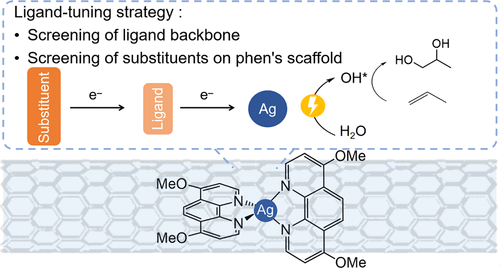84. Ligand Tuning of Molecular Ag Catalysts Enables Efficient Direct Propylene Electrooxidation to Propylene Glycol
Xi Wang,# Si-Min Xu,# An-Zhen Li, Bo-Jun Yuan, Qiujin Shi, Xiang Liu, Ming Xu, Yuanbo Liu, Kejian Kong, Chunyu Zhang, Ruo-Pu Li, Cheng Tang, Zhuo Chen, Bi-Jie Li, and Haohong Duan*
J. Am. Chem. Soc., 2025
DOI: 10.1021/jacs.5c06198

Abstract
Renewable-electricity-driven direct oxidation of propylene (C3H6) presents a sustainable route for propylene glycol (PG) production. Silver (Ag) shows a 30-fold lower price compared to other active noble metals (platinum and palladium) but suffers from low activity. Here, we report a ligand-tuning strategy in Ag-based molecular catalysts for efficient direct C3H6-to-PG conversion. By broad ligand screening, Ag chelated with phenanthroline (phen) and supported on a carbon nanotube (Ag-phen/CNT) was identified to display superior performance. Mechanistic studies revealed that the electron-donating ability of phen facilitated the formation of high-valence Ag-oxo species, which served as the rate-determining step for C3H6 oxidation. Based on the promoting role of the electron-donating effect on catalytic performance, substituents with diverse electron-donating and -withdrawing properties were introduced to the phen’s scaffold. As a result, a linear correlation between the logarithm of the reaction rate and Hammett constants of the substituents was revealed. Based on this correlation, Ag chelated with dimethoxy-substituted phen (Ag-OMe-phen/CNT) was discovered as a more efficient catalyst. In a three-compartment flow cell under a current density of 50 mA cm–2, this catalyst exhibited high PG productivity (432.8 μmol cm–2 h–1), FE (46.5%), selectivity (97.1%), and turnover frequency (73.0 min–1), outperforming previous Ag-based catalysts and is superior to state-of-the-art Pt and Pd catalysts in terms of productivity, selectivity, and TOF. This work shows the great potential of precisely tuning ligands in molecular catalysts to modulate electronic properties for efficient PG electrosynthesis and beyond.



